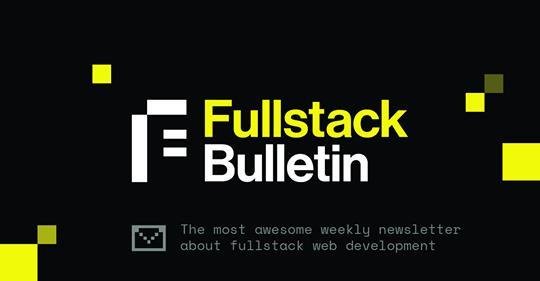Unbundling the JavaScript
module bundler
Luciano Mammino - @loige
21/11/2018



Webpack == PAIN!?





❤️
💔💔



It's not Webpack!
Module bundling is actually complicated!

Luciano... who
Solution Architect at


with @mariocasciaro
with @andreaman87
with @Podgeypoos79
- Why we need modules
- JavaScript module systems
- How a module bundler works
- Webpack in 2 minutes!
- Advanced module bundling
Agenda


App features

Dynamic DOM manipulation
React, Angular, Vue
are so... overrated! 😆
Dynamic Favicon


Custom animated tooltips
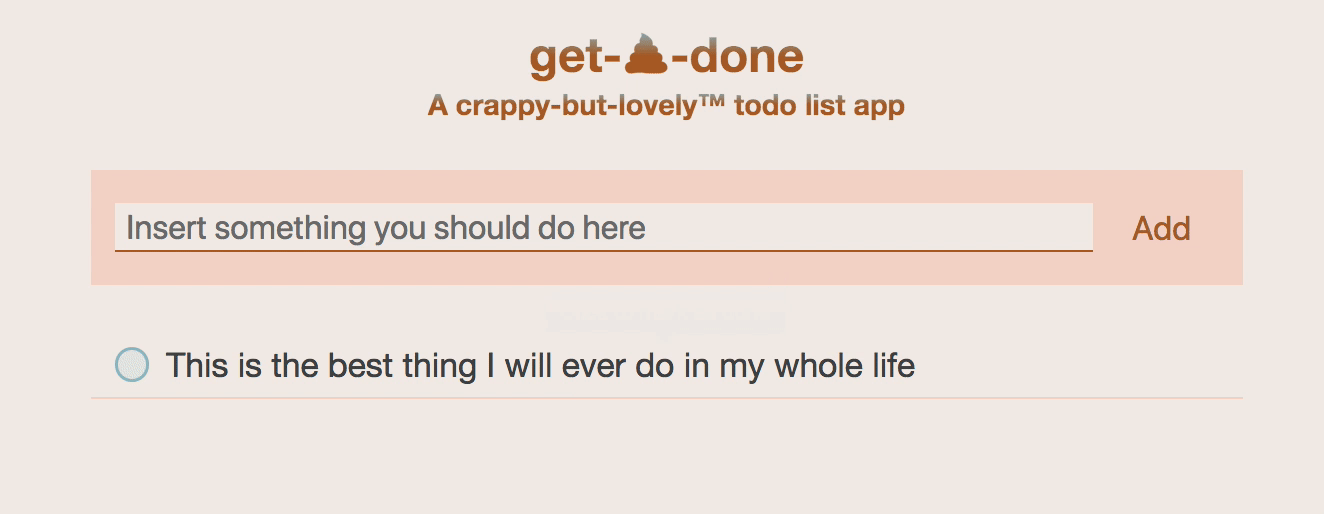

🎉 Confetti rainfall 😱

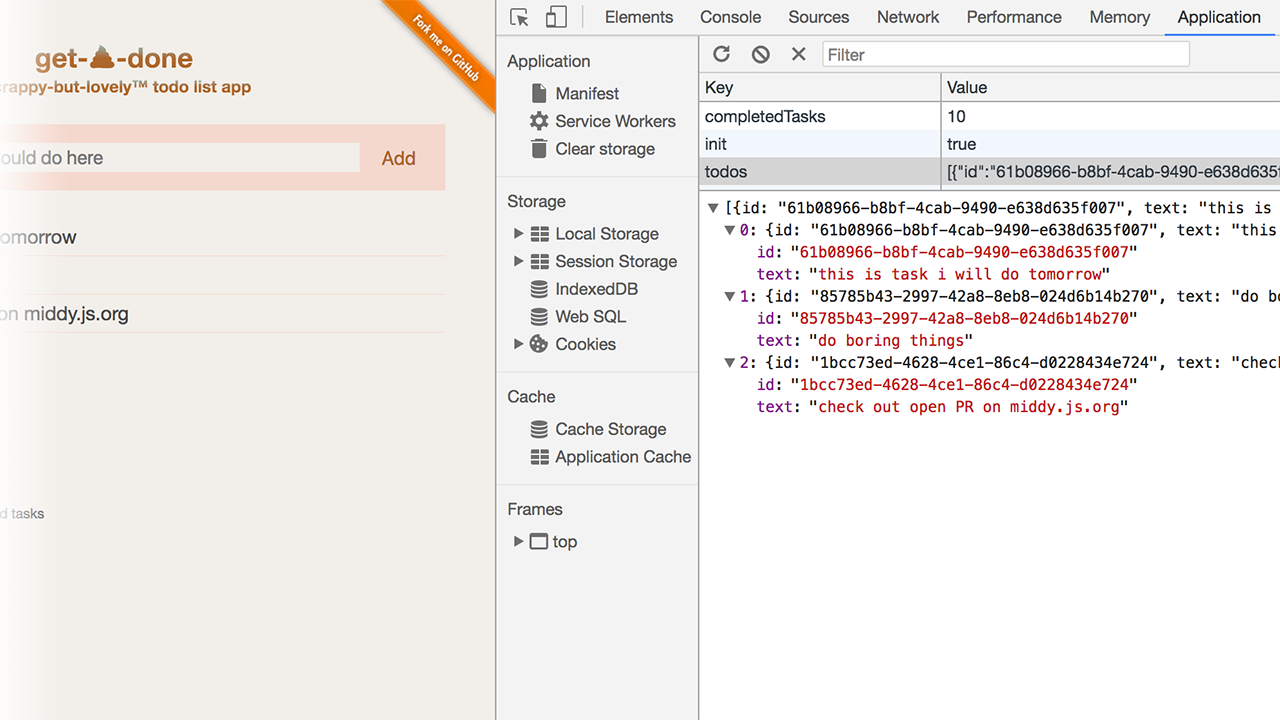
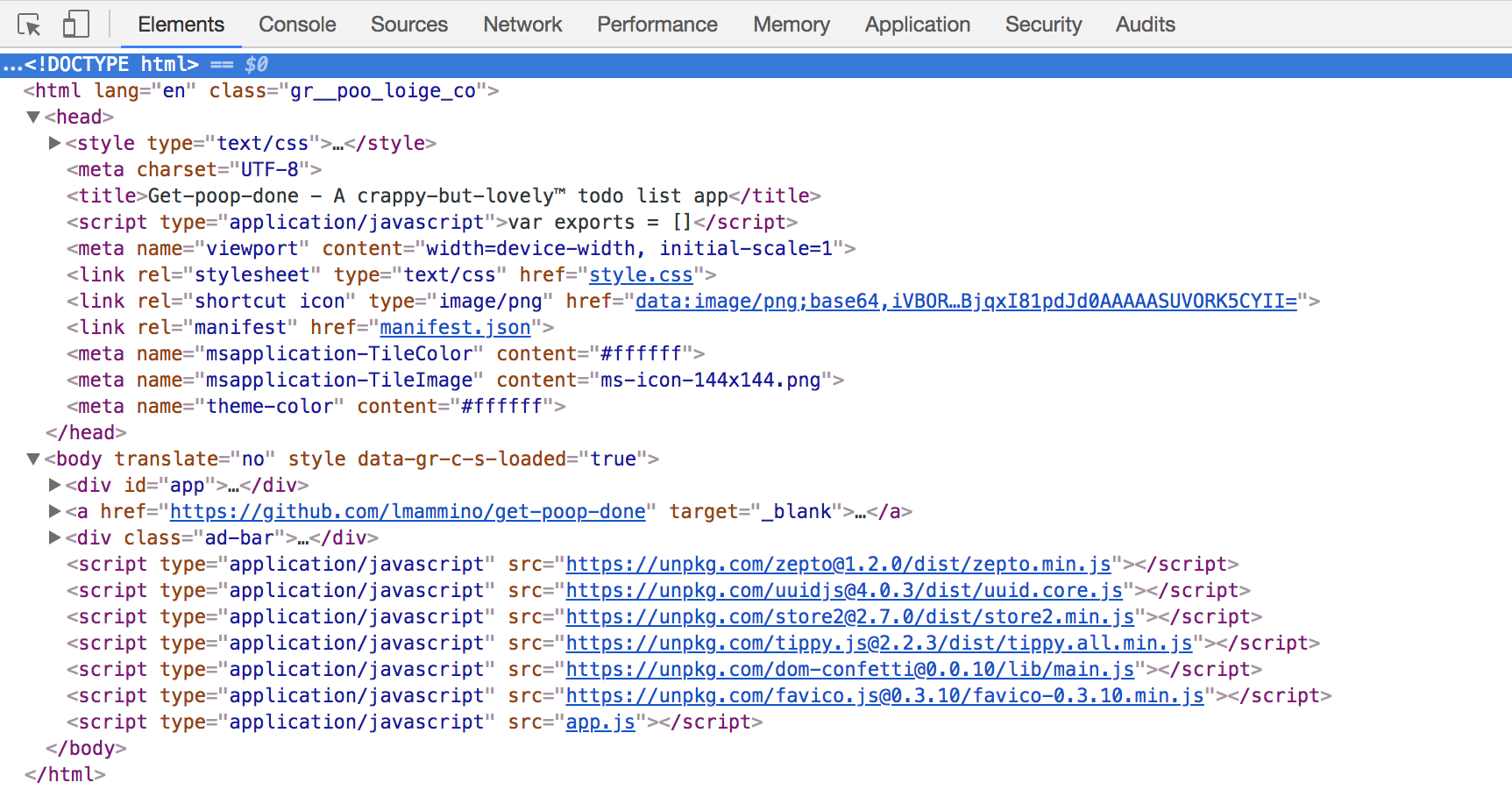
7 Requests only for the JS code!

Current scenario
zepto@1.2.0/dist/zepto.min.js
uuidjs@4.0.3/dist/uuid.core.js
store2@2.7.0/dist/store2.min.js
tippy.js@2.2.3/dist/tippy.all.min.js
confetti@0.0.10/lib/main.js
favico.js@0.3.10/favico-0.3.10.min.js

Ideal scenario
zepto@1.2.0/dist/zepto.min.js
uuidjs@4.0.3/dist/uuid.core.js
store2@2.7.0/dist/store2.min.js
tippy.js@2.2.3/dist/tippy.all.min.js
confetti@0.0.10/lib/main.js
favico.js@0.3.10/favico-0.3.10.min.js
vendors.js

+
+
+
+
+
=

How to do this?


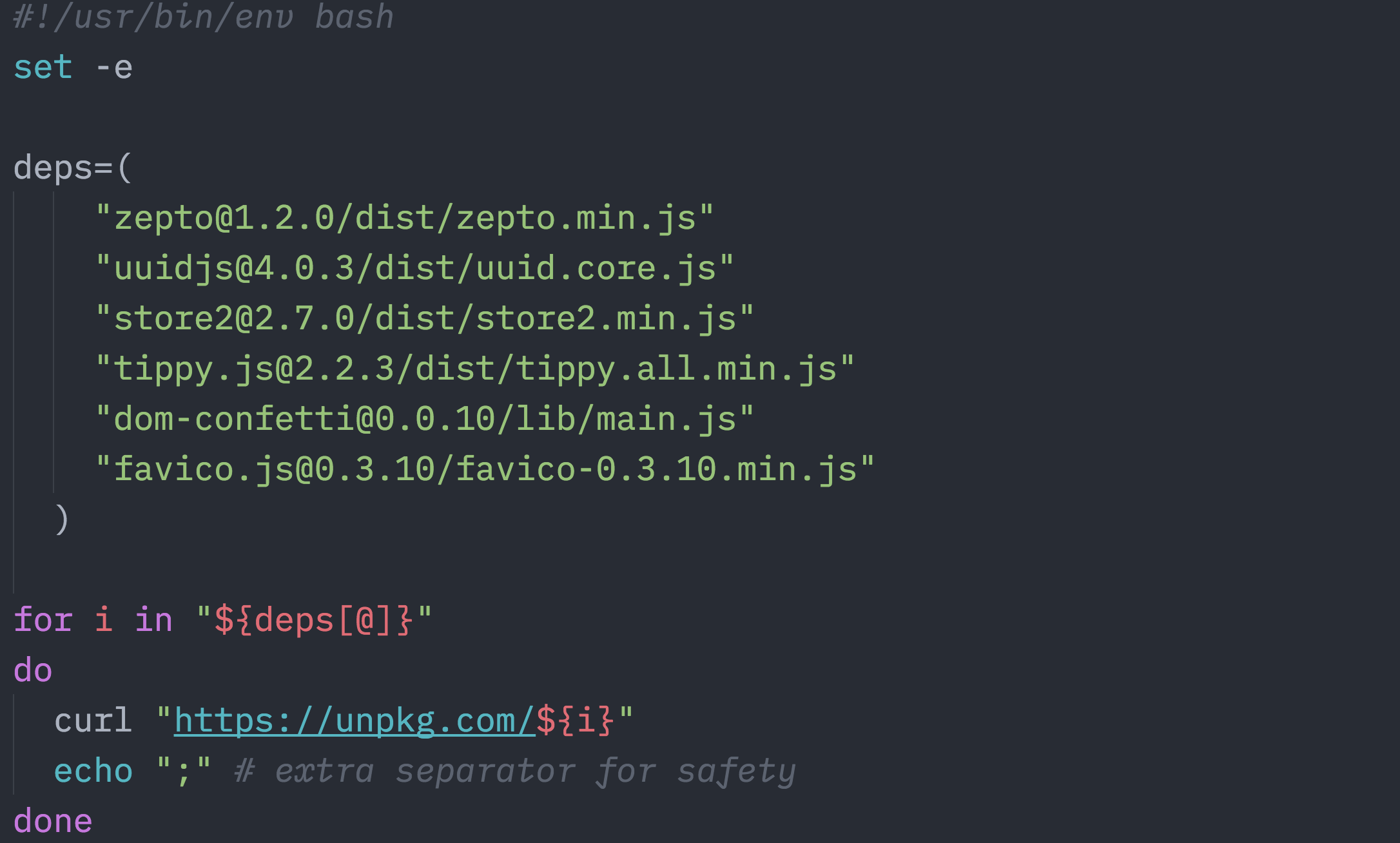
./buildVendors.sh > vendors.js
buildVendors.sh
$
npx lumpy build
$
# lumpy.txt https://unpkg.com/zepto@1.2.0/dist/zepto.min.js https://unpkg.com/uuidjs@4.0.3/dist/uuid.core.js https://unpkg.com/store2@2.7.0/dist/store2.min.js https://unpkg.com/tippy.js@2.2.3/dist/tippy.all.min.js https://unpkg.com/confetti-js@0.0.11/dist/index.min.js https://unpkg.com/dom-confetti@0.0.10/lib/main.js https://unpkg.com/favico.js@0.3.10/favico-0.3.10.min.js
Lumpy allows you to define
all the vendors in a text file
lumpy build
$
- Downloads the files from lumpy.txt (and caches them)
- Concatenates the content of the files
- Minifies the resulting source code (using babel-minify)
- Saves the resulting content in vendors.js







7 requests


2 requests
Even better if you "minify" these!
Concatenation
+
Minification

This is good...
... in 2008
was



Today...
We can do better!
-
Updating them should be easy
-
We shouldn't worry about transitive dependencies
(dependencies of dependencies) -
Order of imports shouldn't really matter

We rely on dependencies!
Dependency

Reusable dependencies...
Modules!
Modules
The bricks for structuring non-trivial applications, but also the main mechanism to enforce information hiding by keeping private all the functions and variables that are not explicitly marked to be exported
* yeah, I quite like quoting my stuff... 😅

- Why we need modules
- JavaScript module systems
- How a module bundler works
- Webpack in 2 minutes!
- Advanced module bundling
Agenda

Meet my friend I.I.F.E.
(Immediately Invoked Function Expression)
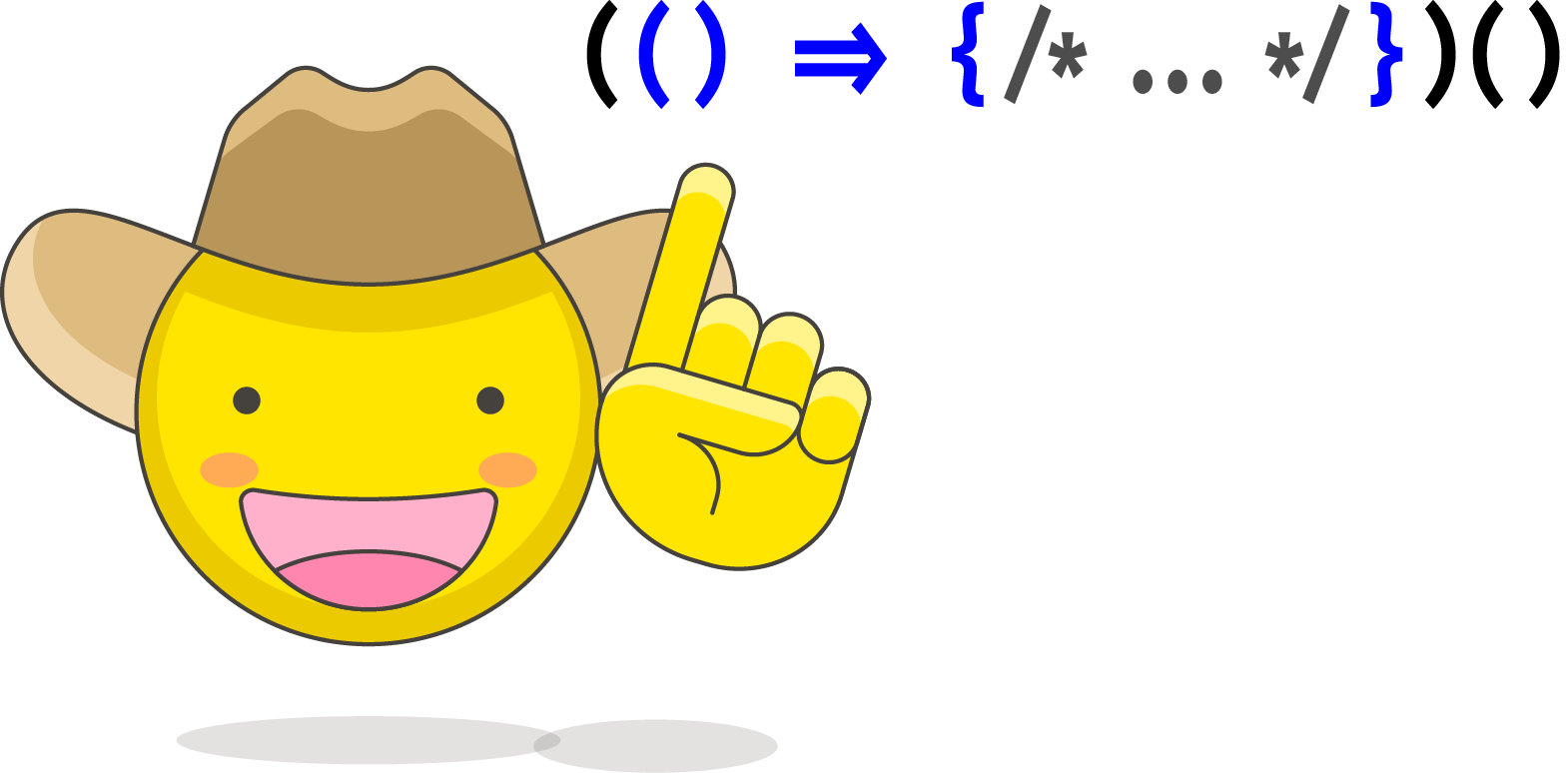
We generally define a function this way
const sum = (a, b) => a + bfunction sum(a, b) {
return a + b
}or
then, at some point, we execute it...
const four = sum(2, 2)A function in JS creates an isolated scope
(a, b) => {
const secretString = "Hello"
return a + b
}
console.log(secretString) // undefinedsecretString is not visible outside the function
IIFE allows you to define an isolated scope that executes itself
(arg1, arg2) => {
// do stuff here
const iAmNotVisibleOutside = true
}

(A function with its own scope
This wrapper executes the function immediately and passes arguments from the outer scope
)(someArg1, someArg2)IIFE is a recurring pattern in
JavaScript modules

Let's implement a module
that provides:
-
Information hiding
-
exported functionalities

const myModule = (() => {
const privateFoo = () => { /* ... */ }
const privateBar = [ /* ... */ ]
const exported = {
publicFoo: () => { /* ... */ },
publicBar: [ /* ... */ ]
};
return exported
})()A module
myModule.publicFoo()
myModule.publicBar[0]
myModule.privateFoo // undefined
myModule.privateBar // undefined
privateFoo // undefined
privateBar // undefinedIIFE
Creates an isolated scope
and executes it
information hiding
non-exposed functionality
defines exported functionalities
propagates the exports
to the outer scope (assigning it to myModule)
Can access exported functionalities
No visibility for the
non-exported ones

We want modules to be
reusable across different apps and organisations...
...we need
A STANDARD MODULE format!

Module system features
Must have
- Simple syntax for import / export
- Information hiding
- Allows to define modules in separate files
- Modules can import from other modules
(nested dependencies)

Module system features
Nice to have
- Ability to import module subsets
- Avoid naming collision
- Asynchronous module loading
- Seamless support for Browsers & Server-side

JavaScript module systems
-
globals
-
CommonJS (Node.js)
-
AMD (Require.js / Dojo)
-
UMD
-
ES2015 Modules (ESM)
-
Many others (SystemJS, ...)

Globals
var $, jQuery
$ = jQuery = (() => {
return { /* ... */ }
})()
// ... use $ or jQuery in the global scope
$.find('.button').remove()Globals
👎 Might generate naming collisions
(e.g. $ overrides browser global variable)
👎 Modules needs to be "fully loaded" in the right order
👎 Cannot import parts of modules
CommonJS
// loDash.js
const loDash = {
/* ... */
}
module.exports = loDash
module
// app.js
// import full module
const _ = require('./loDash')
_.concat([1], [2], [3])
// or import single functionality
const { concat } = require('./loDash')
concat([1], [2], [3])
app using module
CommonJS
👍 No naming collisions
(imported modules can be renamed)
👍 Huge repository of modules through NPM
👎 Synchronous import only
👎 Works natively on the server side only (Node.js)
AMD (Require.js)
Asynchronous Module Definition
// jquery-1.9.0.js
define(
'jquery',
['sizzle', 'jqueryUI'],
function (sizzle, jqueryUI) {
// Returns the exported value
return function () {
// ...
}
}
)
module
module name
dependencies
factory function used to construct the module,
receives the dependencies as arguments
exported value
AMD (Require.js)
Asynchronous Module Definition
// app.js
// define paths
requirejs.config({
baseUrl: 'js/lib',
paths: {
jquery: 'jquery-1.9.0'
}
})
define(['jquery'], function ($) {
// this is executed only when jquery
// and its deps are loaded
});
app
Require.js config
jquery will be loaded from
://<currentDomain>/js/lib/jquery-1.9.0.js
app main function
Has jquery as dependency
AMD (Require.js)
Asynchronous Module Definition
👍 Asynchronous modules
👍 Works on Browsers and Server side
👎 Very verbose and convoluted syntax (my opinion™)
UMD
Universal Module Definition
(function (root, factory) {
if (typeof exports === 'object') {
// CommonJS
module.exports = factory(require('dep'))
} else if (typeof define === 'function' && define.amd) {
// AMD
define(['dep'], function (dep) {
return (root.returnExportsGlobal = factory(dep))
})
} else {
// Global Variables
root.myModule = factory(root.dep)
}
}(this, function (dep) {
// Your actual module
return {}
}))
IIFE with arguments:
- Current scope (this) and the module factory function.
- "dep" is a sample dependency of the module.

👍 Allows you to define modules that
can be used by almost any module loader
👎 Complex, the wrapper code
is almost impossible to write manually
UMD
Universal Module Definition
ES2015 modules
Cool & broad subject, it would deserve it's own talk
Wanna know more?
🔗 import / export syntax reference
🔗 ECMAScript modules in browsers

ES2015 modules
// calculator.js
const add = (num1, num2) => num1 + num2
const sub = (num1, num2) => num1 - num2
const div = (num1, num2) => num1 / num2
const mul = (num1, num2) => num1 * num2
export { add, sub, div, mul }
// app.js
import { add } from './calculator'
console.log(add(2,2)) // 4
module
exported functionalities
app
import specific functionality
ES2015 modules
// index.html
<html>
<body>
<!-- ... -->
<script type="module">
import { add } from 'calculator.js'
console.log(add(2,2)) // 4
</script>
</body>
</html>
"works" in some modern browsers
ES2015 modules
🙄 Syntactically very similar to CommonJS...
BUT
👍 import & export are static
(allow static analysis of dependencies)
👍 It is a (still work in progress) standard format
👍 Works (almost) seamlessly in browsers & servers
So many options...
Current most used practice:
Use CommonJS or ES2015 & create "compiled bundles"

- Why we need modules
- JavaScript module systems
- How a module bundler works
- Webpack in 2 minutes!
- Advanced module bundling
Agenda

Let's try to use CommonJS in the browser

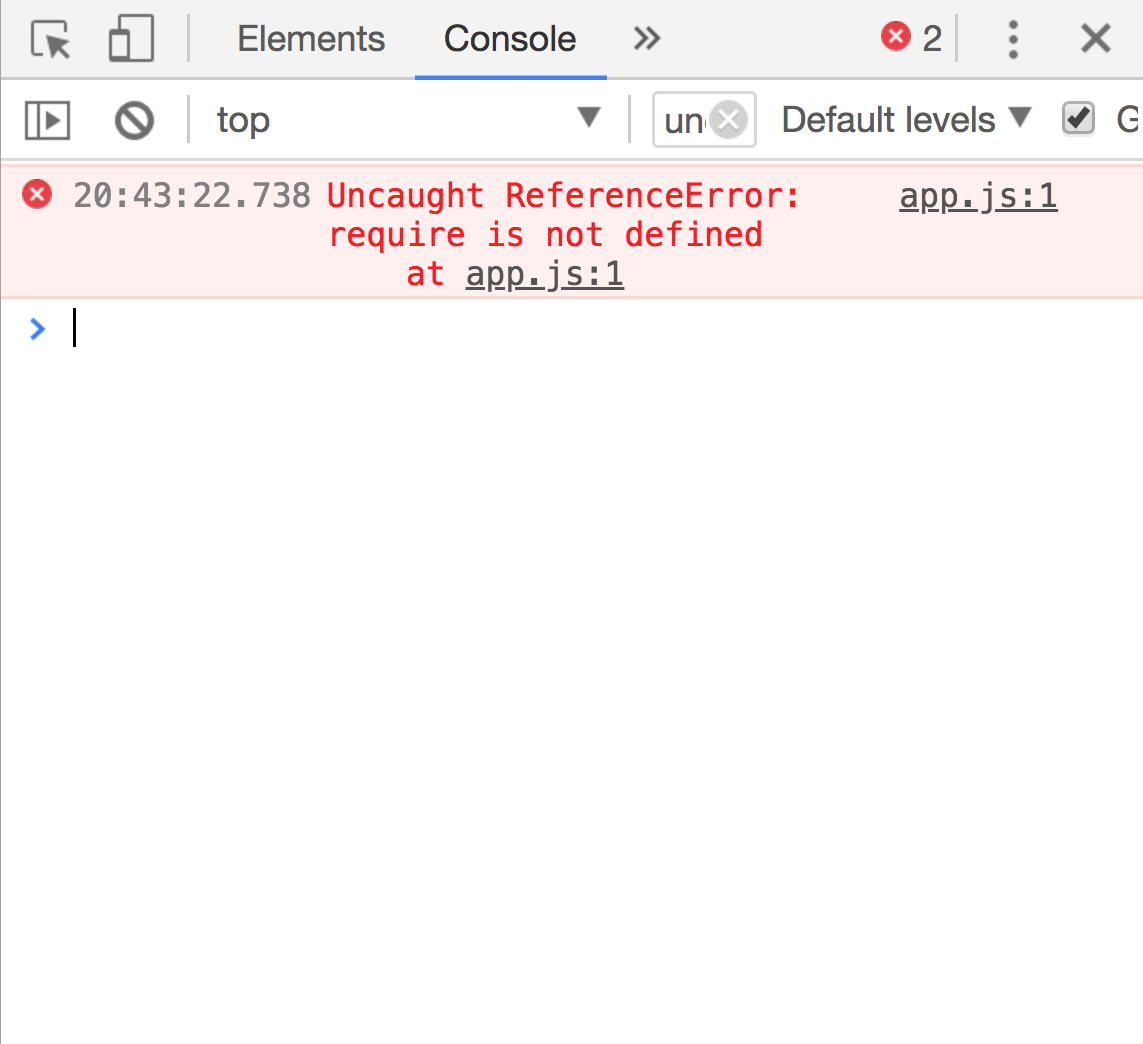
const $ = require('zepto')
const tippy = require('tippy.js')
const UUID = require('uuidjs')
const { confetti } = require('dom-confetti/src/main')
const store = require('store2')
const Favico = require('favico.js')
!(function () {
const colors = ['#a864fd', '#29cdff', '#78ff44', '#ff718d', '#fdff6a']
const todoApp = (rootEl, opt = {}) => {
const todos = opt.todos || []
let completedTasks = opt.completedTasks || 0
const onChange = opt.onChange || (() => {})
const list = rootEl.find('.todo-list')
const footer = rootEl.find('.footer')
const todoCount = footer.find('.todo-count')
const insertInput = rootEl.find('.add-todo-box input')
const insertBtn = rootEl.find('.add-todo-box button')
const render = () => {
let tips
list.html('')
if (todos.length === 0) {
list.html('<div class="nothing"><p>Nothing to do</p><p><small>It\'s good to be lazy 🎉</small></p></div>')
} else {
const listContainer = $('<ul></ul>')
todos.forEach(item => {
const el = $(`<li id="${item.id}"><a title="Click to mark as done" href="#">${item.text}</a></li>`)
el.on('click', (e) => {
e.preventDefault()
const elId = $(e.target).parent().attr('id')
if (tips) tips.destroyAll()
remove(elId)
})
el.on('keyup', (e) => {
if (e.code === 'Enter' || e.code === 'Space') {
e.preventDefault()
const elId = $(e.target).parent().attr('id')
if (tips) tips.destroyAll()
remove(elId)
}
})
const link = el.find('a')
link.on('focus', (e) => {
$(e.target).attr('title', 'Press [space] or [enter] to mark as done')
})
link.on('blur', (e) => {
$(e.target).attr('title', 'Click to mark as done')
})
el.appendTo(listContainer)
})
listContainer.appendTo(list)
tips = tippy(list.find('li').toArray(), {
dynamicTitle: true,
placement: 'top',
animation: 'shift-away',
arrow: 'up',
target: 'a',
trigger: 'focus mouseenter',
theme: 'poo'
})
}
let footerText = todos.length ? `<strong>${todos.length}</strong> task${todos.length !== 1 ? 's' : ''} to get done!` : ''
footerText += completedTasks ? ` <strong>${completedTasks}</strong> completed task${completedTasks !== 1 ? 's' : ''}</strong>` : ''
todoCount.html(footerText)
}
const add = (text) => {
const item = { id: UUID.generate(), text }
todos.push(item)
render()
onChange(todos, completedTasks)
return item
}
const remove = (id) => {
const elIndex = todos.findIndex((item) => item.id === id)
const removedItem = todos.splice(elIndex, 1)[0]
completedTasks++
// every 10 todos completed spread some confetti!
if (completedTasks % 10 === 0) {
confetti(rootEl.get(0), {colors, angle: 45})
}
render()
onChange(todos, completedTasks)
return removedItem
}
const getAll = () => todos
const getRootEl = () => rootEl
insertInput.on('keyup', (e) => {
if (insertInput.val() && e.key === 'Enter') {
e.preventDefault()
add(insertInput.val())
insertInput.val('')
}
})
insertBtn.on('click', (e) => {
e.preventDefault()
if (insertInput.val()) {
add(insertInput.val())
insertInput.val('')
}
})
render()
return ({ add, remove, getAll, getRootEl })
}
const returning = store.get('init')
const storedTodos = store.get('todos', [])
const storedCompletedTasks = store.get('completedTasks', 0)
const favicon = new Favico({
animation: 'popFade', position: 'up'
})
favicon.badge(storedTodos.length)
const app = todoApp($('#app'), {
todos: storedTodos,
completedTasks: storedCompletedTasks,
onChange: (todos, completedTasks) => {
favicon.badge(todos.length)
store('todos', todos)
store('completedTasks', completedTasks)
}
})
store.set('init', true)
if (!returning) {
// for the first init
app.add('Buy soy milk')
app.add('Do homeworks')
app.add('Prepare material for the talk')
app.add('Read SPAM emails')
app.add('Write a module bundler')
app.add('Tick some todos')
app.add('Find a better name for this example')
}
})()
The browser doesn't know how to process
It doesn't support CommonJS!
Module Bundler
A tool that takes modules with dependencies and emits static assets representing those modules
Those static assets can be processed by browsers!

Dependency graph
A graph built by connecting every module with its direct dependencies.

app
dependency A
dependency B
dependency A2
shared
dependency
A module bundler has to:
- Construct the dependency graph (Dependency Resolution)
- Assemble the modules in the graph into a single executable asset (Packing)

// app.js
const calculator = require('./calculator')
const log = require('./log')
log(calculator('2 + 2 / 4'))
// log.js
module.exports = console.log
// calculator.js
const parser = require('./parser')
const resolver = require('./resolver')
module.exports = (expr) => resolver(parser(expr))
// parser.js
module.exports = (expr) => { /* ... */ }
// resolver.js
module.exports = (tokens) => { /* ... */ }Dependency resolution
app
calculator
log
parser
resolver
(entrypoint)
(1)
(2)
(3)
(4)
(5)
During dependency resolution,
the bundler creates a modules map
{
}
'./app': (module, require) => { … },
'./calculator': (module, require) => { … },
'./log': (module, require) => { … },
'./parser': (module, require) => { … },
'./resolver': (module, require) => { … },
const parser = require('./parser');const resolver = require('./resolver');module.exports = (expr) => resolver(parser(expr))
require path
module factory function
Packing

.js
{
--- : ---
--- : ----
--- : --
}
Modules map
Single executable
JS file
Packed executable file
((modulesMap) => {
const require = (name) => {
const module = { exports: {} }
modulesMap[name](module, require)
return module.exports
}
require('./app')
})(
{
'./app': (module, require) => { … },
'./calculator': (module, require) => { … },
'./log': (module, require) => { … },
'./parser': (module, require) => { … },
'./resolver': (module, require) => { … }
}
)IIFE passing the modules map as argument
Custom require function:
it will load the modules by evaluating the code from the modules map
A reference to a module with an empty module.exports.
This will be filled at evaluation time
Invoking the factory function for the given module name.
(Service locator pattern)
The current reference module is passed, the factory function will modify this object by adding the proper exported values.
The custom require function is passed so, modules can recursively require other modules
The resulting module.exports is returned
The entrypoint module is required, triggering the actual execution of the business logic


Now you know how
Module bundlers work!
And how to convert code written using CommonJS to a single file that works in the browser

A challenge for you!
If you do, let me know... I'll arrange a prize for you!
TIP: you can use acorn or babel-parser to parse JavaScript files (look for require and module.exports) and resolve to map relative module paths to actual files in the filesystem.
Need an inspiration?
Check the awesome minipack and @adamisnotdead's w_bp_ck!

Can you build a (simple) module bundler from scratch?
- Why we need modules
- JavaScript module systems
- How a module bundler works
- Webpack in 2 minutes!
- Advanced module bundling
Agenda

A state of the art module bundler for the web
npm install webpack webpack-cli
webpack app.js
yep, recent versions of Webpack work without config! 😎
webpack --mode=development app.js
Do not compress the code and add annotations!
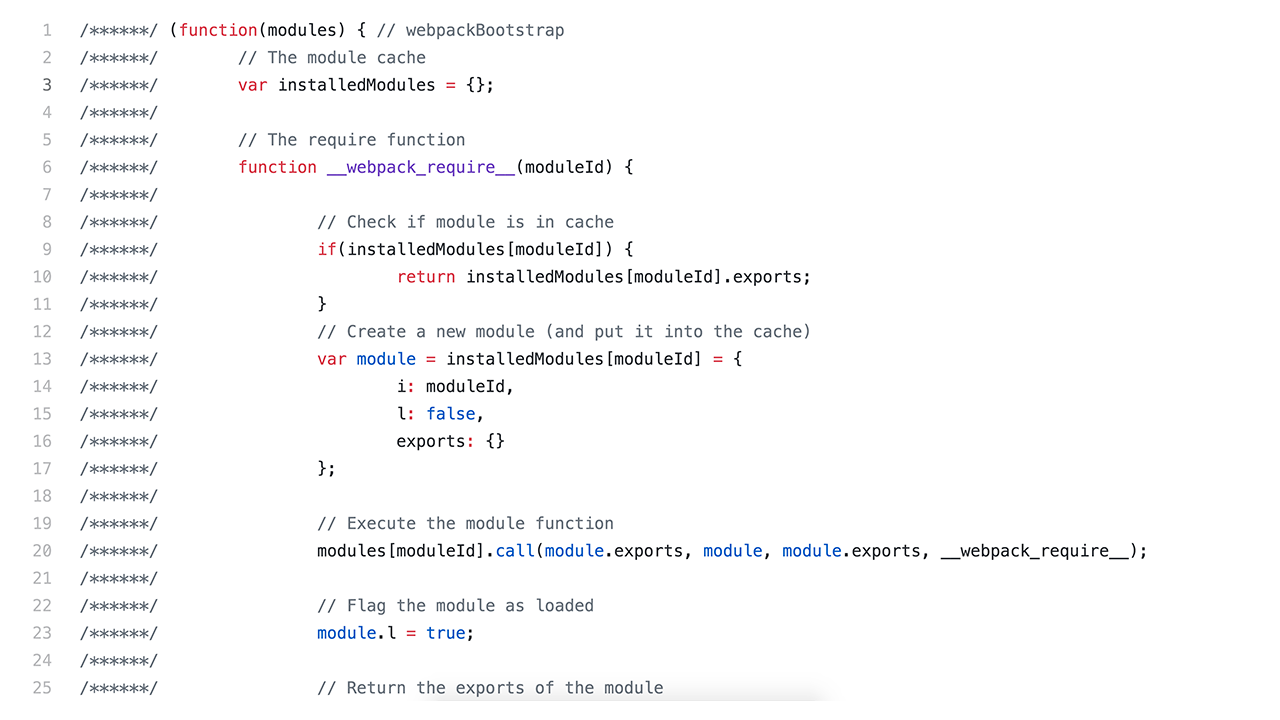
Webpack concepts
- Entry point: the starting file for dependency resolution.
- Output: the destination file (bundled file).
- Loaders: algorithms to parse different file types and convert them into executable javascript (e.g. babel, typescript, but also CSS, images or other static assets)
- Plugins: do extra things (e.g. generate a wrapping HTML or analysis tools)
const { resolve, join } = require('path')
const CompressionPlugin = require('compression-webpack-plugin')
module.exports = {
entry: './app.js',
output: {
path: resolve(join(__dirname, 'build')),
filename: 'app.js'
},
module: {
rules: [
{
test: /\.js$/,
exclude: /(node_modules|bower_components)/,
use: {
loader: 'babel-loader',
options: {
presets: [
['@babel/preset-env']
]
}
}
}
]
},
plugins: [
new CompressionPlugin()
]
}
Webpack.config.js
Entrypoint
Build the dependency graph starting from ./app.js
Output
Save the resulting bundled file in ./build/app.js
Loaders
All the files matching "*.js" are processed with babel and converted to ES5 Javascript
Plugins
Uses a plugin that generates a gzipped copy of every emitted file.
Everything is a module
import React, { Component } from 'react'
import logo from './logo.svg'
import './App.css'
class App extends Component {
render() {
return (
<div className="App">
<header className="App-header">
<img src={logo} className="App-logo" alt="logo" />
<h1 className="App-title">Welcome to React</h1>
</header>
</div>
);
}
}
export default AppWebpack can load any type of file
As long as you can provide a "loader" that tells how to convert the file into something the browser understands.
This is how Webpack allows you to use Babel, TypeScript, Clojure, Elm, Imba but also to load

{
test: /\.css$/,
use: [
require.resolve('style-loader'),
{
loader: require.resolve('css-loader'),
options: {
importLoaders: 1,
},
},
{
loader: require.resolve('postcss-loader'),
options: {
ident: 'postcss',
plugins: () => [
require('postcss-flexbugs-fixes'),
autoprefixer({
browsers: [
'>1%',
'last 4 versions',
'Firefox ESR',
'not ie < 9',
],
flexbox: 'no-2009',
}),
],
},
}
]
}// Defines how to load .css files (uses a pipeline of loaders)
// parses the file with post-css
// process @import and url()
// statements
// inject the resulting code with a <style> tag
...Webpack can do (a lot) more!
- Why we need modules
- JavaScript module systems
- How a module bundler works
- Webpack in 2 minutes!
- Advanced module bundling
Agenda

Bundle cache busting





Device
CDN
Origin
Server


example.com
bundle.js
bundle.js
bundle.js
(original)
bundle.js
(cache copy)
bundle.js
(cache copy)
Bundle cache busting





Device
CDN
Origin
Server


example.com
bundle.js
bundle.js
bundle.js
(original)
bundle.js
(cache copy)
bundle.js
(cache copy)
NEW VERSION
STALE!
STALE!
Bundle cache busting
(Manual) Solution 1
bundle.js?v=1
bundle.js?v=2
bundle.js?v=3
Doesn't play nice with some CDNs and Proxies
(they won't consider different query parameters to be different resources)
Bundle cache busting
(Manual) Solution 2
bundle-v1.js
bundle-v2.js
bundle-v3.js
...
Better, but still a lot of diligence and manual effort needed...
Bundle cache busting
Webpack Solution
bundle.9f61f58dd1cc3bb82182.js bundle.aacdf58ef1aa12382199.js bundle.ed61f68defef3bb82221.js
...
output: {
filename: '[name].[contenthash].js'
}
Bundle cache busting
Webpack Solution
contenthash + webpack-html-plugin
Every new asset version will generate a new file
cache is automatically cleaned up on every release
(if content actually changed)
html-plugin will update the reference to the new file
A good example for dev/prod config
(with create-react-app)
npm i -g create-react-app
create-react-app new-project
cd new-project
npm run eject
cat config/webpack*.js- Why we need modules
- JavaScript module systems
- How a module bundler works
- Webpack in 2 minutes!
- Advanced module bundling
Agenda

Module bundlers are your friends
- Now you know how they work,
they are not (really) magic! - Start small and add more when needed
- If you try to build your own, you'll learn a lot more!

Webpack is not
the only possibility!

THE PRIZE!
npx twaffle --keywords '#oredev #IWANTTOWINAPRIZE'Checkout
Tack så mycket!

Special thanks:
Tadeas from Øredev (for reviewing my stuff thoroughly)
@Podgeypoos79, @andreaman87, @mariocasciaro, @eugenserbanescu (reviewers) and @MarijnJH (inspirations: his amazing book and his workshop on JS modules)
Images by Streamline Emoji pack.

